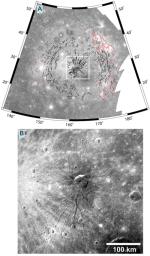Faults in the Caloris Basin
Caption:
As the youngest large impact basin known on Mercury, the Caloris basin has landforms that are better preserved than in older basins, which have been more modified by impact cratering. This figure, recently published in
Science
magazine, shows a map of many linear features within Caloris basin that formed when the near-surface rocks were subjected to large horizontal forces. The Caloris basin contains hundreds of extensional troughs, mapped as black lines, where the surface has been pulled apart and faulted. Pantheon Fossae (located inside the white box of the top map and shown in detail in the bottom image) has over 200 such troughs in a radiating pattern, but near the outer edges of the basin interior troughs are seen in patterns broadly concentric to Caloris basin (see
PIA10606
). The Caloris basin interior also has been deformed by many wrinkle ridges, mapped as red lines, formed when the surface was compressed or shortened horizontally. Relationships between the extensional troughs and contractional wrinkle ridges provide information about the evolution of the Caloris basin and Mercury's interior.
Date Acquired
: January 14, 2008
Instrument
: Narrow Angle Camera (NAC) of the Mercury Dual Imaging System (MDIS)
Scale: Caloris basin is about 1550 kilometers (about 960 miles) in diameter. The crater Apollodorus near the center of Pantheon Fossae is 41 kilometers (25 miles) in diameter.
Background Info:
These images are from MESSENGER, a NASA Discovery mission to conduct the first orbital study of the innermost planet, Mercury. For information regarding the use of images, see the MESSENGER
image use policy
.
Cataloging Keywords:
| Name |
Value |
Additional Values |
| Target |
Mercury |
|
| System |
|
|
| Target Type |
Planet |
|
| Mission |
MESSENGER |
|
| Instrument Host |
MESSENGER |
|
| Host Type |
Orbiter |
|
| Instrument |
Mercury Dual Imaging System (MDIS) |
|
| Detector |
Narrow Angle Camera (NAC) |
|
| Extra Keywords |
Color, Crater, Impact, Map |
| Acquisition Date |
|
| Release Date |
2008-09-03 |
| Date in Caption |
2008-01-14 |
|
| Image Credit |
NASA/Johns Hopkins University Applied Physics Laboratory/Arizona State University/Carnegie Institution of Washington. Figure 1 from McClintock et al., Science, 321, 92-94, 2008. |
| Source |
photojournal.jpl.nasa.gov/catalog/PIA11077 |
| Identifier |
PIA11077 |

 Planetary Data System
Planetary Data System
